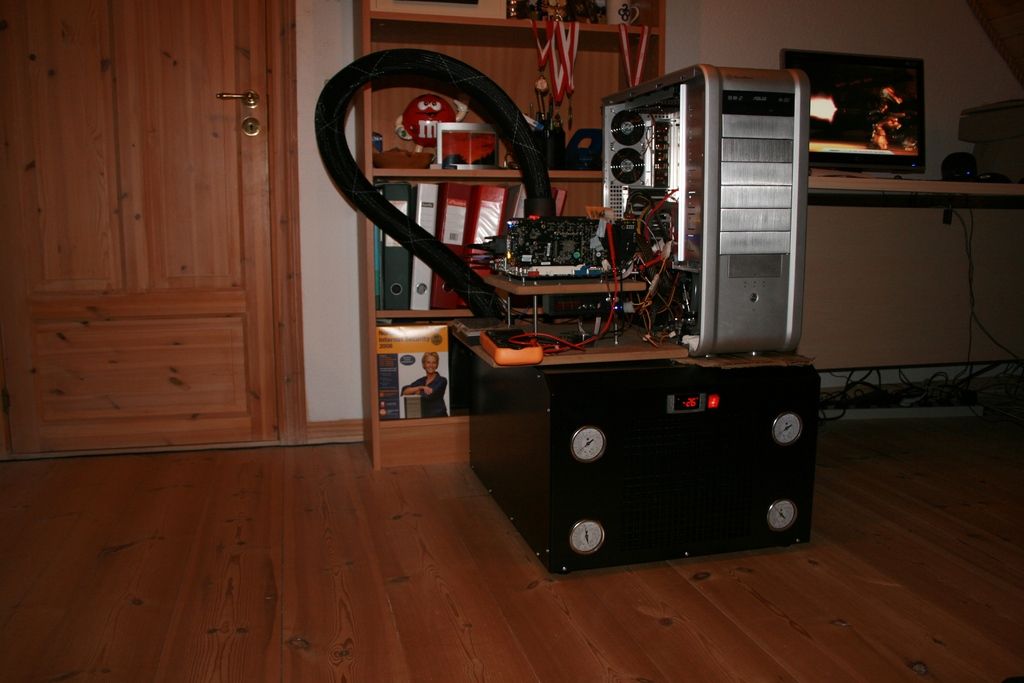PRESSEMEDDELELSE INTEL BEKENDTGØR REKORDINDTJENING I TREDJE KVARTAL 2007 
Omsætning på 10,1 milliarder USD, hvilket er
15 procent over Q3 2006
Driftsindtægt (operating income) på 2,2 milliarder USD,
64 procent over Q3 2006
Rekordstort antal solgte processorer, chipset og flash-enheder
Nettoresultat: 1,9 milliarder USD EPS: 31 cent
København, d. 17. oktober 2007 - Intel Corporation offentliggør i dag deres kvartalsregnskab for tredje kvartal 2007.
President og CEO Paul Otellini kommenterer resultatet:
"En kombination af gode produkter, en stærk og stigende global efterspørgsel og operationel effektivitet gennem vores løbende omstrukturering har ført til en rekordstor omsætning i tredje kvartal og en 64 procents stigning på år-for-år driftsindtægten. Vi forventer, at hvert enkelt at disse elementers positive udvikling vil fortsætte ind i fjerde kvartal, og vi ser meget optimistisk på fremtiden".
Pressemeddelelsens fulde ordlyd: INTEL POSTS RECORD THIRD-QUARTER REVENUE
· Revenue $10.1 Billion, up 15 Percent Year-over-Year
· Operating Income $2.2 Billion, up 64 Percent Year-over-Year
· Record Microprocessor, Chipset and Flash Unit Shipments
· Net Income $1.9 Billion
· EPS 31 Cents
SANTA CLARA, Calif., Oct. 16, 2007 - Intel Corporation today announced third-quarter revenue of $10.1 billion, operating income of $2.2 billion, net income of $1.9 billion and earnings per share (EPS) of 31 cents.
"A combination of great products, strong and growing worldwide demand, and operational efficiency from our ongoing restructuring efforts led to record third-quarter revenue and a 64-percent year-over-year gain in operating income," said Intel President and CEO Paul Otellini. "Looking forward, we see each of these elements continuing to improve into the fourth quarter. We are very pleased with the results and optimistic about our business."
Q3 2007 vs. Q3 2006 vs. Q2 2007
Revenue $10.1 billion +15% +16%
Operating Income $2.2 billion +64% +66%
Net Income $1.9 billion +43% +46%
EPS 31 cents +41% +41%
Results for the third quarter of 2006 included the effects of divestiture gains of $129 million.
Financial Review
· Revenue of $10.1 billion was up 16 percent sequentially, primarily driven by growth in Mobility and Digital Enterprise Group processors of 14 percent, with related chipsets and other products up 19 percent.
§ Total microprocessor units set a record; the average selling price was flat.
§ Chipset and flash memory units set records.
§ Motherboard units were lower.
· Gross margin was 52.4 percent, up from 46.9 percent in the second quarter. The increase was primarily driven by higher microprocessor volumes, lower 45nm start-up costs and lower microprocessor unit costs, partially offset by write-offs for manufacturing costs related to upcoming 45nm processors that had not yet qualified for valuation during the quarter.
· Spending was $2.9 billion, higher than $2.6 billion in the second quarter, primarily driven by higher revenue- and profit-dependent expenses along with higher R&D spending as process engineers moved from 45nm start-up activities to 32nm development.
Business Outlook
The following expectations do not include the potential impact of any mergers, acquisitions, divestitures or other business combinations that may be completed after Oct. 15.
Q4 2007 Outlook
· Revenue: Between $10.5 billion and $11.1 billion.
· Gross margin: 57 percent plus or minus a couple of points.
· Spending (R&D plus MG&A): Between $2.8 billion and $3.0 billion.
· Restructuring and asset impairment charges: Approximately $130 million.
· Net gains from equity investments and interest and other: Approximately $150 million.
· Tax rate: Approximately 29 percent, unchanged.
· Depreciation: Approximately $1.1 billion.
2007 Outlook
· Gross margin: 52 percent plus or minus a point, higher than the previous expectation of 51 percent plus or minus a few points.
· R&D: Approximately $5.8 billion, higher than the previous expectation of approximately $5.7 billion.
· MG&A: Approximately $5.3 billion, higher than the previous expectation of approximately $5.1 billion.
· Capital spending: $4.9 billion plus or minus $200 million, unchanged.
· Depreciation: $4.6 billion plus or minus $100 million, unchanged.
The above statements and any others in this document that refer to plans and expectations for the fourth quarter, the year and the future are forward-looking statements that involve a number of risks and uncertainties. Many factors could affect Intel's actual results, and variances from Intel's current expectations regarding such factors could cause actual results to differ materially from those expressed in these forward-looking statements. Intel presently considers the factors set forth below in the section titled "Risk Factors" to be the important factors that could cause actual results to differ materially from the corporation's published expectations.
Recent Highlights
· Intel shipped more than 2 million quad core processors during the quarter and now offers more than 20 quad-core processor designs.
· Intel introduced the industry's first quad-core processors specifically designed for multi-processor (MP) servers, delivering twice the performance and three times the performance-per-watt of the company's previous-generation products. The introduction completes the company's transition to the energy-efficient Intel® CoreT microprocessor architecture.
· The company launched the next generation of Intel® vProT processor technology for business desktop PCs featuring innovations that better protect against hacking and viruses while giving IT managers new ways to remotely manage and repair systems.
· At the Intel Developer Forum (IDF), the company announced that the world's first 45nm microprocessors, based on Intel's breakthrough 45nm Hi-k metal gate chip technology, will be introduced Nov. 12. The company demonstrated its second-generation 45nm microprocessor architecture, code-named Nehalem, which is on track for production in the second half of next year. Intel also announced the production of test chips based on the company's next-generation, 32nm process technology, scheduled for 2009.
· Also at IDF, Intel announced that its 2008 notebook PC platform, code-named Montevina, will include 25-watt dual-core processors that enable even thinner and lighter designs. Several leading PC makers announced plans to ship Intel Montevina-based notebooks with WiMAX technology next year. Nokia announced plans to include Intel WiMAX silicon in its Internet tablet products, scheduled for 2008.
· Intel acquired Havok, a leading developer of the software used by digital artists to animate movies and computer games. The acquisition will help Intel to accelerate its capabilities in visual computing and graphics.
Risk Factors
· Intel operates in intensely competitive industries that are characterized by a high percentage of costs that are fixed or difficult to reduce in the short term, significant pricing pressures, and product demand that is highly variable and difficult to forecast. Additionally, Intel is in the process of transitioning to its next generation of products on 45nm process technology, and there could be execution issues associated with these changes, including product defects and errata along with lower than anticipated manufacturing yields. Revenue and the gross margin percentage are affected by the timing of new Intel product introductions and the demand for and market acceptance of Intel's products; actions taken by Intel's competitors, including product offerings and introductions, marketing programs and pricing pressures and Intel's response to such actions; Intel's ability to respond quickly to technological developments and to incorporate new features into its products; and the availability of sufficient components from suppliers to meet demand. Factors that could cause demand to be different from Intel's expectations include customer acceptance of Intel's and competitors' products; changes in customer order patterns, including order cancellations; changes in the level of inventory at customers; and changes in business and economic conditions, including conditions in the credit market that could affect consumer confidence and result in lower than expected demand for our products.
· The gross margin percentage could vary significantly from expectations based on changes in revenue levels; product mix and pricing; capacity utilization; variations in inventory valuation, including variations related to the timing of qualifying products for sale; excess or obsolete inventory; manufacturing yields; changes in unit costs; impairments of long-lived assets, including manufacturing, assembly/test and intangible assets; and the timing and execution of the manufacturing ramp and associated costs, including start-up costs.
· Expenses, particularly certain marketing and compensation expenses, vary depending on the level of demand for Intel's products, the level of revenue and profits, and impairments of long-lived assets.
· Intel is in the midst of a structure and efficiency program that is resulting in several actions that could have an impact on expected expense levels and gross margin.
· The tax rate expectation is based on current tax law and current expected income. The tax rate may be affected by the closing of acquisitions or divestitures; the jurisdictions in which profits are determined to be earned and taxed; changes in the estimates of credits, benefits and deductions; the resolution of issues arising from tax audits with various tax authorities, including payment of interest and penalties; and the ability to realize deferred tax assets.
· Gains or losses from equity securities and interest and other could vary from expectations depending on fixed income and equity market volatility; gains or losses realized on the sale or exchange of securities; gains or losses from equity method investments; impairment charges related to marketable, non-marketable and other investments; interest rates; cash balances; and changes in fair value of derivative instruments.
· Intel's results could be affected by the amount, type, and valuation of share-based awards granted as well as the amount of awards cancelled due to employee turnover and the timing of award exercises by employees.
· Intel's results could be impacted by adverse economic, social, political and physical/infrastructure conditions in the countries in which Intel, its customers or its suppliers operate, including military conflict and other security risks, natural disasters, infrastructure disruptions, health concerns and fluctuations in currency exchange rates.
· Intel's results could be affected by adverse effects associated with product defects and errata (deviations from published specifications), and by litigation or regulatory matters involving intellectual property, stockholder, consumer, antitrust and other issues, such as the litigation and regulatory matters described in Intel's SEC reports.
A detailed discussion of these and other factors that could affect Intel's results is included in Intel's SEC filings, including the report on Form 10-Q for the quarter ended June 30, 2007.
Status of Business Outlook
During the quarter, Intel's corporate representatives may reiterate the Business Outlook during private meetings with investors, investment analysts, the media and others. From the close of business on Nov. 30 until publication of the company's fourth-quarter 2007 earnings release, Intel will observe a "Quiet Period" during which the Business Outlook disclosed in the company's press releases and filings with the SEC should be considered to be historical, speaking as of prior to the Quiet Period only and not subject to an update by the company.
Earnings Webcast
Intel will hold a public webcast at 2:30 p.m. PDT today on its Investor Relations Web site at intc.com. A webcast replay and MP3 audio download will also be made available on the site.
Intel, the world leader in silicon innovation, develops technologies, products and initiatives to continually advance how people work and live.







